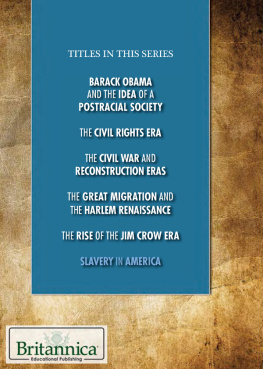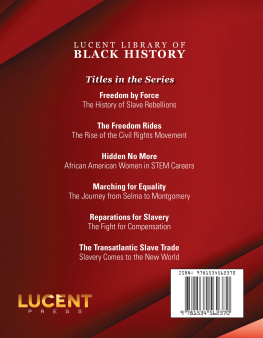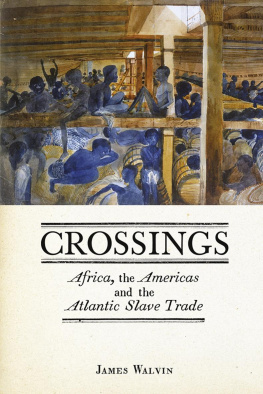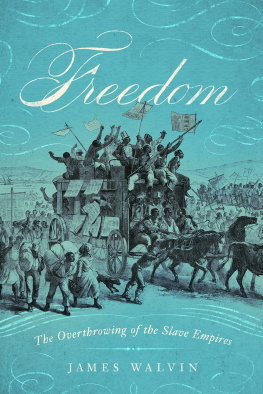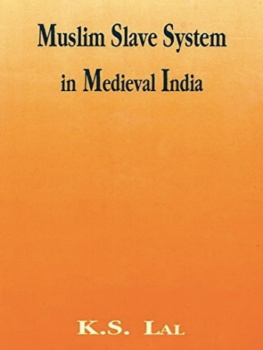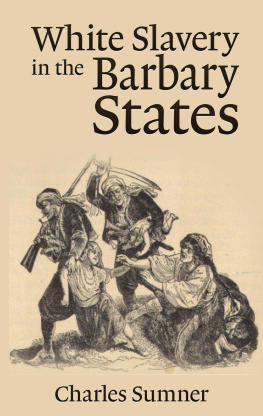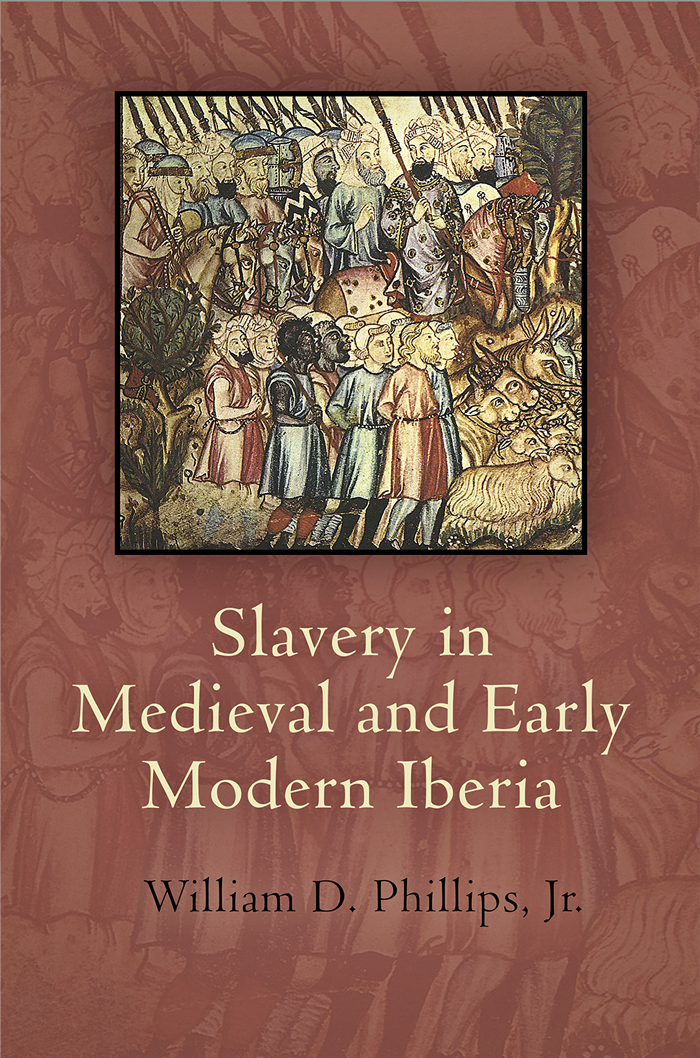Slavery in Medieval
and Early Modern Iberia
Slavery in Medieval
and Early Modern Iberia

William D. Phillips, Jr.

Copyright 2014 University of Pennsylvania Press
All rights reserved. Except for brief quotations used for
purposes of review or scholarly citation, none of this book
may be reproduced in any form by any means without
written permission from the publisher.
Published by
University of Pennsylvania Press
Philadelphia, Pennsylvania 19104-4112
www.upenn.edu/pennpress
Printed in the United States of America on acid-free paper
10 9 8 7 6 5 4 3 2 1
Library of Congress Cataloging-in-Publication Data
Phillips, William D.
Slavery in medieval and early modern Iberia / William D.
Phillips, Jr. 1st ed.
p. cm.
Includes bibliographical references and index.
ISBN 978-0-8122-4491-5 (hardcover : alk. paper)
1. SlaveryIberian PeninsulaHistoryTo 1500.
2. SlaveryIberian PeninsulaHistory16th century.
3. SlavesIberian PeninsulaHistoryTo 1500.
4. SlavesIberian PeninsulaHistory16th century.
I. Title.
HT1216.P465 2013
306.3'620946dc23 2013022778
CONTENTS

Iberian Peninsula and the Balearic Islands, with some principal towns and cities mentioned in the text. Map by Lawrence V. Mott.

Mediterranean and adjacent lands. Map by Lawrence V. Mott.

Atlantic and southeastern Pacific areas. Map by Lawrence V. Mott.
Introduction
Slavery (servitus) is named from saving (servare), for among the ancients, those who were saved from death in battle were called slaves (servi).
Isidore of Seville, early seventh century
This present work of synthesis surveys the history of slavery in Iberia from ancient times to the modern period. It relies in part on the studies of slavery I published in the 1980s but differs greatly in its content, focus, and structure from those earlier works. Though I cite a few archival sources, I have based the work on my reading of as much of the available scholarly literature as possible. This has occupied me for a longer period than I anticipated or would have preferred, in large part because the study of slavery in Iberia has become popular among scholars since the late 1980s. Their publications appeared in a boom period that began in the second half of the 1980s and peaked around the year 2000, though important contributions have continued to appear. This outpouring of material has made it impossible for any one individual to read and digest all that is available. The bibliography indicates what I have been able to do.
Before the 1980s there were a few pioneering studies, and from the mid-twentieth century the most prominent scholar on the topic was Charles Verlinden (19071996). His massive survey of slavery in medieval Europe, the first volume of which appeared in 1955 and covered Iberia and France, relied heavily on legal sources and created interest in a subject that had not been comprehensively studied before.
Several able historians anticipated the boom in Iberian slavery studies in publications that appeared from the 1960s through the 1980s. Among the best known was Vicenta Corts Alonso, who published many articles and an important book on slavery in Valencia at the time of the Catholic Monarchs.
The majority of the older and more recent studies deal with areas of Christian Iberia in the late medieval and early modern centuries. The medieval studies have been most abundant for areas of the late medieval Crown of Aragon, particularly Catalonia, Valencia, and Mallorca. For Castile, the chronological focus has been the period of the fifteenth, sixteenth, and seventeenth centuries. Notably, these works have usually concentrated on local areas and regional patterns, with scholars examining local sources and publishing in local venues. At times these publications dealt with places with important slave populations, whereas elsewhere the number of slaves in the place studied was miniscule even though the records are comprehensive. Studies of slavery in Portugal have not appeared in anything approaching the same numbers as those in Spain, but important and distinguished works are available.
There still has been no comprehensive early modern survey equivalent to Verlindens work on slavery in the Middle Ages. French scholars have perhaps taken the broadest view. Bernard Vincent published a number of important articles on early modern slavery, most of them focused on specific locales. We will mention them in their proper place, but one cuts across regional lines.
Among the locally focused studies of slavery in Spain, one of the most significant books in recent years is that of Aurelia Martn Casares on slavery in sixteenth-century Granada, published in 2000. revolt and their wives and children ended up in captivity and flooded the slave market for a decade or so.
Martn Casares applied a series of skillful and well informed interpretations to her material. She emphasized that women slaves were more numerous throughout the medieval and early modern periods in most places scholars have studied. Among the pioneers in commenting on a number of questions about why more women were sold than men, she has suggested that scholars should reflect on how the lives and work of men and women slaves differed, why women tended to command higher prices, what premium derived from womens reproductive abilities, and the vulnerability of women slaves to sexual exploitation within the domestic context. She also insisted that the individuals should be accorded their full humanity. She excoriated earlier scholars for their use of terms that objectify individuals and groups. She argued that the modern use of words such as piece (pieza) to mean an individual slave, or male (varn) and female (hembra) to describe men and women, has tended to perpetuate the attitudes of the sixteenth-century slave owners. She even avoided to the extent possible the word slave (esclavo and esclava), preferring to use the term enslaved person (as, for example, mujer esclavizada) or captive (e.g., hombre cautivado). In this way, she endeavored to emphasize that slavery was a condition people were subjected to, and, even though enslaved, they were still human beings, not something less. This is a worthwhile reminder to all those who study slavery in the past, as is her application of feminist and gender theory.
Other scholars have recently published significant works on slavery in Iberia. These include Roser Salicr i Lluch, who works on Catalonia and particularly Barcelona, and Debra Blumenthal, whose primary focus is Valencia. In 1998 Salicr i Lluch published an important book on slaves and slave owners in late medieval Barcelona. Since then she has published significant articles on topics such as slaves in artisanry, fugitives, and the profitability of slavery. in which she mines the rich late medieval documentation of the city and kingdom and comes to new conclusions about the agency slaves exercised, both as individuals and in collectivities, and unusual tasks assigned to slaves, such as settling their owners scores when honor was involved. They attacked their owners rivals and in the process did harm to the rivals bodies as well as damage to their reputations.


